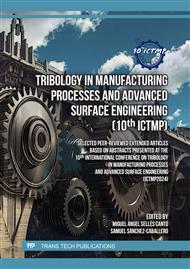[1]
Y. Ding, F. Zhang, H. Zhou, S. Cheng, K. Xu, Z. Wang, S. Xie, J. Tian, Effect of Al Content on the Long-Term Corrosion Behavior of Arc-Sprayed ZnAl Alloy Coatings, Coatings 13(10) (2023)
DOI: 10.3390/coatings13101720
Google Scholar
[2]
J. Kawakita, T. Fukushima, S. Kuroda, T. Kodama, Corrosion behaviour of HVOF sprayed SUS316L stainless steel in seawater, Corrosion science 44(11) (2002) 2561-2581.
DOI: 10.1016/s0010-938x(02)00030-6
Google Scholar
[3]
F. Ahnia, B. Demri, Evaluation of aluminum coatings in simulated marine environment, Surface and Coatings Technology 220 (2013) 232-236.
DOI: 10.1016/j.surfcoat.2012.12.011
Google Scholar
[4]
Z. Kong, Y. Jin, G.M.S. Hossen, S. Hong, Y. Wang, Q.-V. Vu, V.-H. Truong, Q. Tao, S.-E. Kim, Experimental and theoretical study on mechanical properties of mild steel after corrosion, Ocean Engineering 246 (2022) 110652.
DOI: 10.1016/j.oceaneng.2022.110652
Google Scholar
[5]
M. Hauer, K.M. Henkel, S. Krebs, W. Kroemmer, Alternative gas mixtures in arc spraying: a chance to improve coating properties and residual stress states, Journal of Thermal Spray Technology 27 (2018) 106-118.
DOI: 10.1007/s11666-017-0650-6
Google Scholar
[6]
K. Dejun, D. Xuequan, W. Jinchun, Effects of anodic oxidation on corrosion properties of Al coating by arc spraying in seawater, Surface and Interface Analysis 47(9) (2015) 911-918.
DOI: 10.1002/sia.5796
Google Scholar
[7]
J. Lin, Z. Wang, P. Lin, J. Cheng, X. Zhang, S. Hong, Microstructure and cavitation erosion behavior of FeNiCrBSiNbW coating prepared by twin wires arc spraying process, Surface and Coatings Technology 240 (2014) 432-436.
DOI: 10.1016/j.surfcoat.2013.12.071
Google Scholar
[8]
V. Geamăn, M.A. Pop, I. Radomir, D.L. Motoc, Ni-5Al-cladding by thermal arc spraying, International Journal of Modern Manufacturing Technologies 6(1) (2014) 55-58.
Google Scholar
[9]
Z. Panossian, L. Mariaca, M. Morcillo, S. Flores, J. Rocha, J. Peña, F. Herrera, F. Corvo, M. Sanchez, O. Rincon, Steel cathodic protection afforded by zinc, aluminium and zinc/aluminium alloy coatings in the atmosphere, Surface and Coatings Technology 190(2-3) (2005) 244-248.
DOI: 10.1016/j.surfcoat.2004.04.023
Google Scholar
[10]
S. Sugimura, J. Liao, Long-term corrosion protection of arc spray Zn-Al-Si coating system in dilute chloride solutions and sulfate solutions, Surface and Coatings Technology 302 (2016)
DOI: 10.1016/j.surfcoat.2016.06.042
Google Scholar
[11]
W. Wu, G. Sun, Q. Wang, S. Lin, Preparation, Wear Resistance, and Corrosion Performance of Arc-Sprayed Zn, Al, and Zn-Al Coatings on Carbon Steel Substrates, Journal of Materials Engineering and Performance (2023) 1-14.
DOI: 10.1007/s11665-023-07889-3
Google Scholar
[12]
H. Min Su, W. Yong Bin, K. Seok-Cheol, Y.-J. Jeong, J. Seok Ki, K. Seong-Jong, Effects of thickness of Al thermal spray coating for STS 304, Transactions of Nonferrous Metals Society of China 19(4) (2009) 925-929.
DOI: 10.1016/s1003-6326(08)60379-9
Google Scholar
[13]
W.M. Zhao, C. Liu, L.X. Dong, Y. Wang, Effects of Arc Spray Process Parameters on Corrosion Resistance of Ti Coatings, Journal of Thermal Spray Technology 18(4) (2009) 702-707.
DOI: 10.1007/s11666-009-9392-4
Google Scholar
[14]
New Zealand. STANDARDS, AS/NZS 1594:2002 Hot-rolled steel flat products., 2002.
Google Scholar
[15]
New Zealand. STEEL, Data Sheet of HA350 (Hot-Rolled), 2012.
Google Scholar
[16]
New Zealand. STANDARDS, Durability requirements for steel structures and components, 2018.
Google Scholar
[17]
ASTM Committee, Standard Guide for Laboratory Immersion Corrosion Testing of Metals, ASTM G31, ASTM International, West Conshohocken, PA, USA, 2021.
Google Scholar
[18]
A. Committee, Standard Practice for Exposure of Metals and Alloys by Alternate Immersion in Neutral 3.5 % Sodium Chloride Solution, 2021.
DOI: 10.1520/g0044-99
Google Scholar
[19]
D.I. Seo, J.B. Lee, Localized corrosion and repassivation behaviors of additively manufactured titanium alloys in simulated biomedical solutions, npj Materials Degradation 7(1) (2023) 44.
DOI: 10.1038/s41529-023-00363-4
Google Scholar
[20]
M. Barbosa, J. Bastos, J. Garcı́a-Jareño, F. Vicente, Chloride role in the surface of nickel electrode, Electrochimica acta 44(6-7) (1998) 957-965.
DOI: 10.1016/s0013-4686(98)00199-6
Google Scholar
[21]
J. Huang, Y. Liu, J. Yuan, H. Li, Al/Al2O3 Composite Coating Deposited by Flame Spraying for Marine Applications: Alumina Skeleton Enhances Anti-Corrosion and Wear Performances, Journal of Thermal Spray Technology 23(4) (2014) 676-683.
DOI: 10.1007/s11666-014-0056-7
Google Scholar
[22]
H. Kwon, Y. Park, U.H. Nam, E. Lee, E. Byon, Comparative Research on Corrosion Resistant Non-Skid Al and Al-3%Ti Coating Fabricated by Twin Wire arc Spraying, Korean J. Met. Mater. 61(4) (2023) 242-251.
DOI: 10.3365/kjmm.2023.61.4.242
Google Scholar
[23]
W. Wu, G. Sun, Q. Wang, S. Lin, Preparation, Wear Resistance, and Corrosion Performance of Arc-Sprayed Zn, Al, and Zn-Al Coatings on Carbon Steel Substrates, Journal of Materials Engineering and Performance 32(23) (2023) 10542-10555.
DOI: 10.1007/s11665-023-07889-3
Google Scholar



